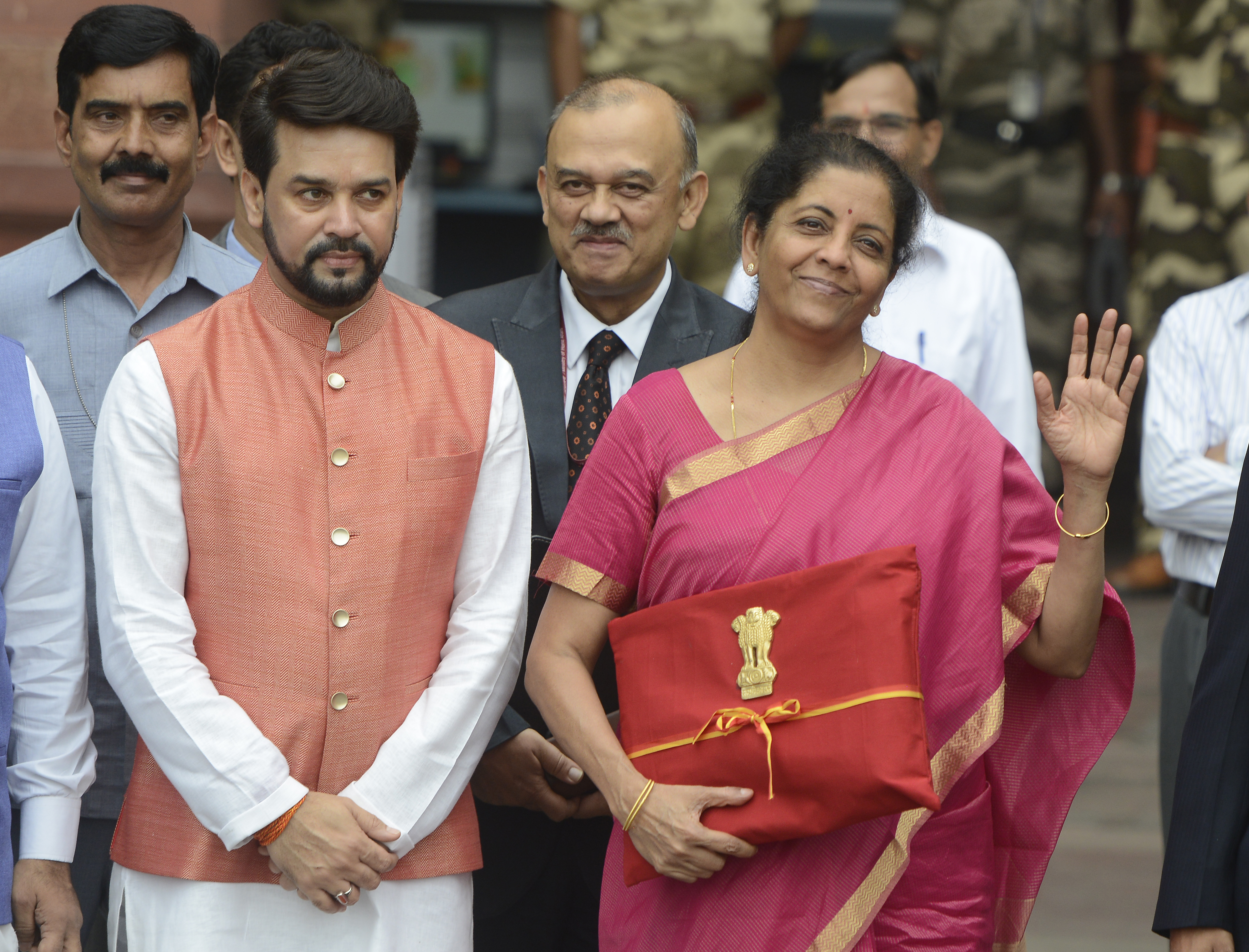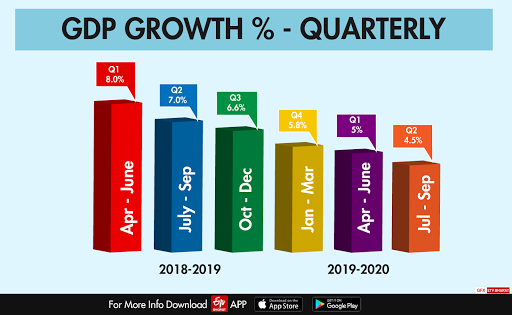ಹೈದರಾಬಾದ್: ಫೆಬ್ರವರಿ 1ರಂದು ಹಣಕಾಸು ಸಚಿವೆ ನಿರ್ಮಲಾ ಸೀತಾರಾಮನ್ ಅವರು ತಮ್ಮ ಮೊದಲ ಪೂರ್ಣ ಪ್ರಮಾಣದ ಬಜೆಟ್ ಅನ್ನು ಮಂಡಿಸಲಿದ್ದಾರೆ.
‘ಕೋಟ್ಯಧಿಪತಿ’ಯಿಂದ ಜನ ಸಾಮಾನ್ಯರವರೆಗೆ, ಕಾಶ್ಮೀರದಿಂದ ಕನ್ಯಾಕುಮಾರಿಯವರೆಗೂ ಇಡೀ ದೇಶವೇ ಬಜೆಟ್ ಭಾಷಣದತ್ತ ದೃಷ್ಟಿ ಹಾಯಿಸಿದೆ. ಈ ಬಜೆಟ್ ಕುಸಿತದ ಹಾದಿಯಲ್ಲಿರುವ ಭವಿಷ್ಯದ ಆರ್ಥಿಕತೆಯನ್ನು ಪುನರುಜ್ಜೀವನಗೊಳಿಸಲಿದೆ ಎಂಬ ಭರವಸೆ ಇರಿಸಿಕೊಳ್ಳಲಾಗಿದೆ.
ಭಾರತೀಯ ಆರ್ಥಿಕತೆಯು ಕಳೆದ 11 ವರ್ಷಗಳ ಅವಧಿಯಲ್ಲಿ ಪ್ರಸ್ತುತ ನಿಧಾನಗತಿಯಲ್ಲಿ ಬೆಳೆಯುತ್ತಿದೆ. ನಿರುದ್ಯೋಗದ ಪ್ರಮಾಣವು ನಾಲ್ಕು ದಶಕಗಳಲ್ಲಿ ಗರಿಷ್ಠ ಮಟ್ಟದಲ್ಲಿದೆ. ಆಹಾರ ಪದಾರ್ಥಗಳ ಬೆಲೆಗಳು ಗಗನಮುಖಿಯಾಗಿವೆ.
ಕೌಶಲ್ಯ ರಹಿತ ಕಾರ್ಮಿಕರ ದೊಡ್ಡ ವಲಯದ ಉತ್ಪಾದನಾ ವಲಯವು ಮಂದಗತಿಯಲ್ಲಿದ್ದು, ಕೃಷಿ ಮತ್ತು ಗ್ರಾಮೀಣ ಬೆಳವಣಿಗೆಗೆಯಂತಹ ನಿರ್ಣಾಯಕ ಕ್ಷೇತ್ರಗಳು ಶೇ 3 ಕ್ಕಿಂತ ಕಡಿಮೆ ಬೆಳೆವಣಿಗೆ ಹೊಂದುತ್ತಿವೆ.
ದಾವೋಸ್ನಲ್ಲಿ ನಡೆದ ವಿಶ್ವ ಆರ್ಥಿಕ ವೇದಿಕೆ ಶೃಂಗಸಭೆಯ ಹೊರತಾಗಿ ಇತ್ತೀಚೆಗೆ ಬಿಡುಗಡೆಯಾದ ವಿಶ್ವ ಆರ್ಥಿಕ ಔಟ್ಲೋಕ್, ಜಾಗತಿಕ ಸಾಮಾಜಿಕ ಚಲನಶೀಲತೆ ಸೂಚ್ಯಂಕ ಮತ್ತು ಆಕ್ಸ್ಫ್ಯಾಮ್ ವರದಿಯು ಭಾರತದ ಸಂಪತ್ತು ಸೃಷ್ಟಿ ಪ್ರಮಾಣವು ಕ್ಷೀಣಿಸುತ್ತಿದೆ. ಶ್ರೀಮಂತ - ಬಡವರ ವಿಭಜನೆಗೆ ಕಡಿವಾಣ ಹಾಕಲು ದೃಢವಾದ ಕ್ರಮಗಳನ್ನು ತೆಗೆದುಕೊಳ್ಳುವುದು ಅಗತ್ಯವಿದೆ ಎಂದು ಸೂಚಿಸಿದೆ.
ನಿರ್ಮಲಾ ಮುಂದಿರುವ ಹಾದಿ?
ಪ್ರಸ್ತುತದಲ್ಲಿನ ಆರ್ಥಿಕ ಕುಸಿತವು ಪೂರೈಕೆ ಅಡಚಣೆಗಳಿಗಿಂತ ಬೇಡಿಕೆಯ ಅಡ್ಡ ಸಮಸ್ಯೆಗಳಿಂದಾಗಿ ಕಂಡುಬರುತ್ತದೆ. ಮಾರುಕಟ್ಟೆಯಲ್ಲಿ ಸಾಕಷ್ಟು ಸರಕು ಮತ್ತು ಸೇವೆಗಳು ಲಭ್ಯವಿದ್ದರೂ ಸಹ ಜನರ ಖರೀದಿಗೆ ಮುಂದಾಗುತ್ತಿಲ್ಲ. ಇಂದಿನ ಈಗನ ಮಂದಗತಿಗೆ ಮುಖ್ಯ ಕಾರಣವಾಗಿದೆ.
2019ರಲ್ಲಿ ಆರ್ಬಿಐ ಬಡ್ಡಿದರವನ್ನು (ರೆಪೊ ದರ) 135 ಬೇಸಿಸ್ ಪಾಯಿಂಟ್ಗಳಷ್ಟು (ಶೇ 1.35ರಷ್ಟು) ಕಡಿಮೆ ಮಾಡುವ ಮೂಲಕ ಗೃಹ, ಕಾರು ಖರೀದಿಸುವಂತಹ ಬೇಡಿಕೆಯನ್ನು ಸೃಜಿಸುವ ಪ್ರಯತ್ನ ಮಾಡಿಕೊಂಡು ಬಂದಿದೆ. ದುರಾದೃಷ್ಟವಶಾತ್, ಈ ಕ್ರಮಗಳು ನಿರೀಕ್ಷಿತ ಫಲಿತಾಂಶಗಳನ್ನು ನೀಡಲಿಲ್ಲ.
ಆಯ್ದ ವಲಯಗಳಲ್ಲಿ ಸಾರ್ವಜನಿಕ ಹೂಡಿಕೆಗಳು ಮತ್ತು ಖರ್ಚನ್ನು ಹೆಚ್ಚಿಸುವ ಮೂಲಕ ಆರ್ಥಿಕ ಮಂದಗತಿಯನ್ನು ಹೋಗಲಾಡಿಸಲು ಮುಂಬರುವ ಬಜೆಟ್ನಲ್ಲಿ ವಿವೇಕಯುತ ನಡೆಗಳನ್ನು ತೆಗೆದುಕೊಳ್ಳುವುದು ಉತ್ತಮ.
ವಿತ್ತೀಯ ಕೊರತೆಯ ಮಿಥ್: ವಿತ್ತೀಯ ಕೊರತೆಯು ಹಣಕಾಸು ವರ್ಷದಲ್ಲಿ ಸರ್ಕಾರಕ್ಕೆ ಅಗತ್ಯವಿರುವ ಒಟ್ಟು ಸಾಲದ ಸೂಚಕವಾಗಿದೆ. ಇದು ಆದಾಯ ಮತ್ತು ವೆಚ್ಚದ ನಡುವಿನ ವ್ಯತ್ಯಾಸ ತಿಳಿಸುತ್ತದೆ.ಸರ್ಕಾರಿ ಖರ್ಚು ಹೆಚ್ಚಾದಂತೆ ಹಣಕಾಸಿನ ಕೊರತೆಯ ಪರದೆ ವಿಸ್ತರಿಸಿಕೊಳ್ಳುತ್ತ ಹೋಗುತ್ತದೆ. ಅದು ಮುಂದೆ ಹೆಚ್ಚಿನ ಬೆಲೆ ಏರಿಕೆಗೆ ಕಾರಣವಾಗಬಹುದು. ಅಂತಿಮವಾಗಿ ಇದು ಬೆಳವಣಿಗೆಯನ್ನು ಕುಂಠಿತಗೊಳಿಸಿ ದೊಡ್ಡ ಸಮಸ್ಯೆಗಳಿಗೆ ಕಾರಣವಾಗಬಹುದು ಎಂಬ ವಾದಗಳು ಚಾಲ್ತಿಯಲ್ಲಿವೆ.
ಇಂತಹ ಸನ್ನಿವೇಶದಲ್ಲಿಯೇ ಸರ್ಕಾರದ ಹೆಚ್ಚಿನ ಖರ್ಚು ಬೆಲೆ ಏರಿಕೆಯಂತಹ ವಿಷಮ ಪರಿಸ್ಥಿತಿಗೆ ಕಾರಣವಾಗಬಹುದು. ಯಾವುದೇ ಒಂದು ಉದ್ಯಮವು ತನ್ನಲ್ಲಿ ಲಭ್ಯವಿರುವ ಸಾಮರ್ಥ್ಯವನ್ನು ಎಷ್ಟರ ಮಟ್ಟಿಗೆ ಬಳಸಿಕೊಳ್ಳುತ್ತಿದೆ ಎಂಬುದರ ಮೇಲೆ ಅದರ ಸಾಮರ್ಥ್ಯದ ಬಳಕೆ ಅಡಗಿರುತ್ತದೆ. ಆದರೆ, ಆರ್ಬಿಐ ವರದಿಯು 'ಆರ್ಥಿಕತೆಯಲ್ಲಿ ಬಳಕೆಯಾಗದಷ್ಟು ಸಾಮರ್ಥ್ಯವಿದೆ' ಎಂದು ಸೂಚಿಸಿದೆ. ಸರ್ಕಾರದ ಹೆಚ್ಚಿನ ವೆಚ್ಚವು ಉದ್ಯೋಗವನ್ನು ಸೃಷ್ಟಿಸುತ್ತದೆ. ಜನರ ಕೈಯಲ್ಲಿ ಅಧಿಕ ಗಳಿಕೆ ಹರಿದಾಡುವಂತೆ ಮಾಡುತ್ತದೆ. ಈ ಆದಾಯ ಬಳಕೆಗೆ ತೊಡಗಿಸಿಕೊಳ್ಳುತ್ತಾರೆ. ಗುಣಾತ್ಮಕ ಪರಿಣಾಮದಿಂದಾಗಿ ಆರ್ಥಿಕತೆಯು ಪುನರುಜ್ಜೀವನಗೊಳ್ಳುತ್ತದೆ.
ಮುಂದಿನ ಹಂತದಲ್ಲಿನ ವ್ಯವಹಾರದ ವಿಶ್ವಾಸ ವೃದ್ಧಿಯು ತೆರಿಗೆ ಆದಾಯವನ್ನು ಸುಧಾರಿಸುತ್ತದೆ. ಹಾದಿ ತಪ್ಪಿದ ಹಣಕಾಸಿನ ಪರಿಸ್ಥಿತಿಗಳು ಸರಿಯಾದ ಮಾರ್ಗದತ್ತ ವಾಲುತ್ತವೆ. ಆದರಿಂದ ಹಣಕಾಸು ಕೊರತೆಯ ಅಂಕಿ- ಅಂಶಗಳು ಹೆಚ್ಚಾಗಿದ್ದರೆ ಆತಂಕಪಡುವ ಅಗತ್ಯವಿಲ್ಲ. ಉತ್ತಮ ನಾಳೆಗಾಗಿ ನಾವು ಇಂದು ಪಾವತಿಸಬೇಕಾದ ಬೆಲೆಗಳಿವು.
ವಲಯವಾರು ನಿರ್ದಿಷ್ಟ ಖರ್ಚಿನ ಅಗತ್ಯವಿದೆ
ಖರ್ಚು ಮಾಡಬೇಕೇ ಅಥವಾ ಬೇಡವೇ ಎಂಬ ಬಗ್ಗೆ ಸ್ಪಷ್ಟತೆ ಬಂದರೆ ಎಲ್ಲಿ ಖರ್ಚು ಮಾಡಬೇಕು ಎಂಬ ಪ್ರಶ್ನೆ ಮೂಡುತ್ತದೆ. ಕೃಷಿ ಕೂಡ ಅಂತಹ ಕ್ಷೇತ್ರವಾಗಿದೆ. ಹೆಚ್ಚಿನ ಸರ್ಕಾರಿ ಹೂಡಿಕೆಯೊಂದಿಗೆ ಉತ್ತಮ ಫಲಿತಾಂಶ ನೀಡುತ್ತಿದೆ.
ಜಿಡಿಪಿಯ ಶೇಕಡಾವಾರು ಕೃಷಿ ಆದಾಯವು 2001-11ರ ಅವಧಿಗೆ ಹೋಲಿಸಿದರೆ 2012 ರಿಂದ 18 ಅವಧಿ ಮಧ್ಯೆ 3.1 ಪ್ರತಿಶತಕ್ಕೆ ಇಳಿದಿದೆ. 2002-11ರ ಅವಧಿಯಲ್ಲಿ ಅದು ಶೇ 4.4ರಷ್ಟಿತ್ತು. ಕೃಷಿ ಆದಾಯದ ಕುಸಿತವು ಬಳಕೆಯನ್ನು ತಗ್ಗಿಸುತ್ತದೆ. ಇದರ ಆದಾಯವನ್ನು ಹೆಚ್ಚಿಸುವ ಮೂಲಕ ಬಳಕೆಯ ಬೇಡಿಕೆಯನ್ನು ಪುನರುಜ್ಜೀವನಗೊಳಿಸುವುದು ನಮ್ಮ ಮುಂದೆ ಇರುವ ಕಾರ್ಯವಾಗಿದೆ.
ಹೂಡಿಕೆಗಳ ಮೂಲಕ ಗ್ರಾಮೀಣ ಮೂಲಸೌಕರ್ಯ ಮತ್ತು ಮೌಲ್ಯವನ್ನು ಹೆಚ್ಚಿಸುವ ಪೂರೈಕೆಯನ್ನು ವೃದ್ಧಿಸಬಹುದು. ಇದು ಮೂಲಸೌಕರ್ಯಗಳನ್ನು ಸೃಷ್ಟಿಸುವುದಲ್ಲದೇ ಗ್ರಾಮೀಣ ದೃಷ್ಟಿಕೋನವನ್ನು ಬದಲಿಸುತ್ತದೆ. ಆರ್ಥಿಕತೆಯು ಮತ್ತೆ ಪುಟೆದೇಳಲು ಸಹಾಯ ಮಾಡುತ್ತದೆ. 'ಇದು ಖರ್ಚು ಮಾಡುವ ಸಮಯ ಹಾಗೂ ಸುಖಸುಮ್ಮನೆ ಖರ್ಚು ಮಾಡುವುದಕ್ಕಿಂತ ಸರಿಯಾಗಿ ಖರ್ಚು ಮಾಡುವುದು ಮುಖ್ಯ'ವಾಗುತ್ತದೆ.
ಡಾ.ಮಹೇಂದ್ರ ಬಾಬು ಕುರುವಾ
ಉತ್ತರಖಂಡದ ಎಚ್.ಎನ್.ಬಿ.ಗರ್ವಾಲ್ ಕೇಂದ್ರ ವಿಶ್ವವಿದ್ಯಾಲಯದ ಸಹಾಯಕ ಪ್ರಾಧ್ಯಾಪಕ
ಹೈದರಾಬಾದ್: ಫೆಬ್ರವರಿ 1ರಂದು ಹಣಕಾಸು ಸಚಿವೆ ನಿರ್ಮಲಾ ಸೀತಾರಾಮನ್ ಅವರು ತಮ್ಮ ಮೊದಲ ಪೂರ್ಣ ಪ್ರಮಾಣದ ಬಜೆಟ್ ಅನ್ನು ಮಂಡಿಸಲಿದ್ದಾರೆ.
‘ಕೋಟ್ಯಧಿಪತಿ’ಯಿಂದ ಜನ ಸಾಮಾನ್ಯರವರೆಗೆ, ಕಾಶ್ಮೀರದಿಂದ ಕನ್ಯಾಕುಮಾರಿಯವರೆಗೂ ಇಡೀ ದೇಶವೇ ಬಜೆಟ್ ಭಾಷಣದತ್ತ ದೃಷ್ಟಿ ಹಾಯಿಸಿದೆ. ಈ ಬಜೆಟ್ ಕುಸಿತದ ಹಾದಿಯಲ್ಲಿರುವ ಭವಿಷ್ಯದ ಆರ್ಥಿಕತೆಯನ್ನು ಪುನರುಜ್ಜೀವನಗೊಳಿಸಲಿದೆ ಎಂಬ ಭರವಸೆ ಇರಿಸಿಕೊಳ್ಳಲಾಗಿದೆ.
ಭಾರತೀಯ ಆರ್ಥಿಕತೆಯು ಕಳೆದ 11 ವರ್ಷಗಳ ಅವಧಿಯಲ್ಲಿ ಪ್ರಸ್ತುತ ನಿಧಾನಗತಿಯಲ್ಲಿ ಬೆಳೆಯುತ್ತಿದೆ. ನಿರುದ್ಯೋಗದ ಪ್ರಮಾಣವು ನಾಲ್ಕು ದಶಕಗಳಲ್ಲಿ ಗರಿಷ್ಠ ಮಟ್ಟದಲ್ಲಿದೆ. ಆಹಾರ ಪದಾರ್ಥಗಳ ಬೆಲೆಗಳು ಗಗನಮುಖಿಯಾಗಿವೆ.
ಕೌಶಲ್ಯ ರಹಿತ ಕಾರ್ಮಿಕರ ದೊಡ್ಡ ವಲಯದ ಉತ್ಪಾದನಾ ವಲಯವು ಮಂದಗತಿಯಲ್ಲಿದ್ದು, ಕೃಷಿ ಮತ್ತು ಗ್ರಾಮೀಣ ಬೆಳವಣಿಗೆಗೆಯಂತಹ ನಿರ್ಣಾಯಕ ಕ್ಷೇತ್ರಗಳು ಶೇ 3 ಕ್ಕಿಂತ ಕಡಿಮೆ ಬೆಳೆವಣಿಗೆ ಹೊಂದುತ್ತಿವೆ.
ದಾವೋಸ್ನಲ್ಲಿ ನಡೆದ ವಿಶ್ವ ಆರ್ಥಿಕ ವೇದಿಕೆ ಶೃಂಗಸಭೆಯ ಹೊರತಾಗಿ ಇತ್ತೀಚೆಗೆ ಬಿಡುಗಡೆಯಾದ ವಿಶ್ವ ಆರ್ಥಿಕ ಔಟ್ಲೋಕ್, ಜಾಗತಿಕ ಸಾಮಾಜಿಕ ಚಲನಶೀಲತೆ ಸೂಚ್ಯಂಕ ಮತ್ತು ಆಕ್ಸ್ಫ್ಯಾಮ್ ವರದಿಯು ಭಾರತದ ಸಂಪತ್ತು ಸೃಷ್ಟಿ ಪ್ರಮಾಣವು ಕ್ಷೀಣಿಸುತ್ತಿದೆ. ಶ್ರೀಮಂತ - ಬಡವರ ವಿಭಜನೆಗೆ ಕಡಿವಾಣ ಹಾಕಲು ದೃಢವಾದ ಕ್ರಮಗಳನ್ನು ತೆಗೆದುಕೊಳ್ಳುವುದು ಅಗತ್ಯವಿದೆ ಎಂದು ಸೂಚಿಸಿದೆ.
ನಿರ್ಮಲಾ ಮುಂದಿರುವ ಹಾದಿ?
ಪ್ರಸ್ತುತದಲ್ಲಿನ ಆರ್ಥಿಕ ಕುಸಿತವು ಪೂರೈಕೆ ಅಡಚಣೆಗಳಿಗಿಂತ ಬೇಡಿಕೆಯ ಅಡ್ಡ ಸಮಸ್ಯೆಗಳಿಂದಾಗಿ ಕಂಡುಬರುತ್ತದೆ. ಮಾರುಕಟ್ಟೆಯಲ್ಲಿ ಸಾಕಷ್ಟು ಸರಕು ಮತ್ತು ಸೇವೆಗಳು ಲಭ್ಯವಿದ್ದರೂ ಸಹ ಜನರ ಖರೀದಿಗೆ ಮುಂದಾಗುತ್ತಿಲ್ಲ. ಇಂದಿನ ಈಗನ ಮಂದಗತಿಗೆ ಮುಖ್ಯ ಕಾರಣವಾಗಿದೆ.
2019ರಲ್ಲಿ ಆರ್ಬಿಐ ಬಡ್ಡಿದರವನ್ನು (ರೆಪೊ ದರ) 135 ಬೇಸಿಸ್ ಪಾಯಿಂಟ್ಗಳಷ್ಟು (ಶೇ 1.35ರಷ್ಟು) ಕಡಿಮೆ ಮಾಡುವ ಮೂಲಕ ಗೃಹ, ಕಾರು ಖರೀದಿಸುವಂತಹ ಬೇಡಿಕೆಯನ್ನು ಸೃಜಿಸುವ ಪ್ರಯತ್ನ ಮಾಡಿಕೊಂಡು ಬಂದಿದೆ. ದುರಾದೃಷ್ಟವಶಾತ್, ಈ ಕ್ರಮಗಳು ನಿರೀಕ್ಷಿತ ಫಲಿತಾಂಶಗಳನ್ನು ನೀಡಲಿಲ್ಲ.
ಆಯ್ದ ವಲಯಗಳಲ್ಲಿ ಸಾರ್ವಜನಿಕ ಹೂಡಿಕೆಗಳು ಮತ್ತು ಖರ್ಚನ್ನು ಹೆಚ್ಚಿಸುವ ಮೂಲಕ ಆರ್ಥಿಕ ಮಂದಗತಿಯನ್ನು ಹೋಗಲಾಡಿಸಲು ಮುಂಬರುವ ಬಜೆಟ್ನಲ್ಲಿ ವಿವೇಕಯುತ ನಡೆಗಳನ್ನು ತೆಗೆದುಕೊಳ್ಳುವುದು ಉತ್ತಮ.
ವಿತ್ತೀಯ ಕೊರತೆಯ ಮಿಥ್: ವಿತ್ತೀಯ ಕೊರತೆಯು ಹಣಕಾಸು ವರ್ಷದಲ್ಲಿ ಸರ್ಕಾರಕ್ಕೆ ಅಗತ್ಯವಿರುವ ಒಟ್ಟು ಸಾಲದ ಸೂಚಕವಾಗಿದೆ. ಇದು ಆದಾಯ ಮತ್ತು ವೆಚ್ಚದ ನಡುವಿನ ವ್ಯತ್ಯಾಸ ತಿಳಿಸುತ್ತದೆ.ಸರ್ಕಾರಿ ಖರ್ಚು ಹೆಚ್ಚಾದಂತೆ ಹಣಕಾಸಿನ ಕೊರತೆಯ ಪರದೆ ವಿಸ್ತರಿಸಿಕೊಳ್ಳುತ್ತ ಹೋಗುತ್ತದೆ. ಅದು ಮುಂದೆ ಹೆಚ್ಚಿನ ಬೆಲೆ ಏರಿಕೆಗೆ ಕಾರಣವಾಗಬಹುದು. ಅಂತಿಮವಾಗಿ ಇದು ಬೆಳವಣಿಗೆಯನ್ನು ಕುಂಠಿತಗೊಳಿಸಿ ದೊಡ್ಡ ಸಮಸ್ಯೆಗಳಿಗೆ ಕಾರಣವಾಗಬಹುದು ಎಂಬ ವಾದಗಳು ಚಾಲ್ತಿಯಲ್ಲಿವೆ.
ಇಂತಹ ಸನ್ನಿವೇಶದಲ್ಲಿಯೇ ಸರ್ಕಾರದ ಹೆಚ್ಚಿನ ಖರ್ಚು ಬೆಲೆ ಏರಿಕೆಯಂತಹ ವಿಷಮ ಪರಿಸ್ಥಿತಿಗೆ ಕಾರಣವಾಗಬಹುದು. ಯಾವುದೇ ಒಂದು ಉದ್ಯಮವು ತನ್ನಲ್ಲಿ ಲಭ್ಯವಿರುವ ಸಾಮರ್ಥ್ಯವನ್ನು ಎಷ್ಟರ ಮಟ್ಟಿಗೆ ಬಳಸಿಕೊಳ್ಳುತ್ತಿದೆ ಎಂಬುದರ ಮೇಲೆ ಅದರ ಸಾಮರ್ಥ್ಯದ ಬಳಕೆ ಅಡಗಿರುತ್ತದೆ. ಆದರೆ, ಆರ್ಬಿಐ ವರದಿಯು 'ಆರ್ಥಿಕತೆಯಲ್ಲಿ ಬಳಕೆಯಾಗದಷ್ಟು ಸಾಮರ್ಥ್ಯವಿದೆ' ಎಂದು ಸೂಚಿಸಿದೆ. ಸರ್ಕಾರದ ಹೆಚ್ಚಿನ ವೆಚ್ಚವು ಉದ್ಯೋಗವನ್ನು ಸೃಷ್ಟಿಸುತ್ತದೆ. ಜನರ ಕೈಯಲ್ಲಿ ಅಧಿಕ ಗಳಿಕೆ ಹರಿದಾಡುವಂತೆ ಮಾಡುತ್ತದೆ. ಈ ಆದಾಯ ಬಳಕೆಗೆ ತೊಡಗಿಸಿಕೊಳ್ಳುತ್ತಾರೆ. ಗುಣಾತ್ಮಕ ಪರಿಣಾಮದಿಂದಾಗಿ ಆರ್ಥಿಕತೆಯು ಪುನರುಜ್ಜೀವನಗೊಳ್ಳುತ್ತದೆ.
ಮುಂದಿನ ಹಂತದಲ್ಲಿನ ವ್ಯವಹಾರದ ವಿಶ್ವಾಸ ವೃದ್ಧಿಯು ತೆರಿಗೆ ಆದಾಯವನ್ನು ಸುಧಾರಿಸುತ್ತದೆ. ಹಾದಿ ತಪ್ಪಿದ ಹಣಕಾಸಿನ ಪರಿಸ್ಥಿತಿಗಳು ಸರಿಯಾದ ಮಾರ್ಗದತ್ತ ವಾಲುತ್ತವೆ. ಆದರಿಂದ ಹಣಕಾಸು ಕೊರತೆಯ ಅಂಕಿ- ಅಂಶಗಳು ಹೆಚ್ಚಾಗಿದ್ದರೆ ಆತಂಕಪಡುವ ಅಗತ್ಯವಿಲ್ಲ. ಉತ್ತಮ ನಾಳೆಗಾಗಿ ನಾವು ಇಂದು ಪಾವತಿಸಬೇಕಾದ ಬೆಲೆಗಳಿವು.
ವಲಯವಾರು ನಿರ್ದಿಷ್ಟ ಖರ್ಚಿನ ಅಗತ್ಯವಿದೆ
ಖರ್ಚು ಮಾಡಬೇಕೇ ಅಥವಾ ಬೇಡವೇ ಎಂಬ ಬಗ್ಗೆ ಸ್ಪಷ್ಟತೆ ಬಂದರೆ ಎಲ್ಲಿ ಖರ್ಚು ಮಾಡಬೇಕು ಎಂಬ ಪ್ರಶ್ನೆ ಮೂಡುತ್ತದೆ. ಕೃಷಿ ಕೂಡ ಅಂತಹ ಕ್ಷೇತ್ರವಾಗಿದೆ. ಹೆಚ್ಚಿನ ಸರ್ಕಾರಿ ಹೂಡಿಕೆಯೊಂದಿಗೆ ಉತ್ತಮ ಫಲಿತಾಂಶ ನೀಡುತ್ತಿದೆ.
ಜಿಡಿಪಿಯ ಶೇಕಡಾವಾರು ಕೃಷಿ ಆದಾಯವು 2001-11ರ ಅವಧಿಗೆ ಹೋಲಿಸಿದರೆ 2012 ರಿಂದ 18 ಅವಧಿ ಮಧ್ಯೆ 3.1 ಪ್ರತಿಶತಕ್ಕೆ ಇಳಿದಿದೆ. 2002-11ರ ಅವಧಿಯಲ್ಲಿ ಅದು ಶೇ 4.4ರಷ್ಟಿತ್ತು. ಕೃಷಿ ಆದಾಯದ ಕುಸಿತವು ಬಳಕೆಯನ್ನು ತಗ್ಗಿಸುತ್ತದೆ. ಇದರ ಆದಾಯವನ್ನು ಹೆಚ್ಚಿಸುವ ಮೂಲಕ ಬಳಕೆಯ ಬೇಡಿಕೆಯನ್ನು ಪುನರುಜ್ಜೀವನಗೊಳಿಸುವುದು ನಮ್ಮ ಮುಂದೆ ಇರುವ ಕಾರ್ಯವಾಗಿದೆ.
ಹೂಡಿಕೆಗಳ ಮೂಲಕ ಗ್ರಾಮೀಣ ಮೂಲಸೌಕರ್ಯ ಮತ್ತು ಮೌಲ್ಯವನ್ನು ಹೆಚ್ಚಿಸುವ ಪೂರೈಕೆಯನ್ನು ವೃದ್ಧಿಸಬಹುದು. ಇದು ಮೂಲಸೌಕರ್ಯಗಳನ್ನು ಸೃಷ್ಟಿಸುವುದಲ್ಲದೇ ಗ್ರಾಮೀಣ ದೃಷ್ಟಿಕೋನವನ್ನು ಬದಲಿಸುತ್ತದೆ. ಆರ್ಥಿಕತೆಯು ಮತ್ತೆ ಪುಟೆದೇಳಲು ಸಹಾಯ ಮಾಡುತ್ತದೆ. 'ಇದು ಖರ್ಚು ಮಾಡುವ ಸಮಯ ಹಾಗೂ ಸುಖಸುಮ್ಮನೆ ಖರ್ಚು ಮಾಡುವುದಕ್ಕಿಂತ ಸರಿಯಾಗಿ ಖರ್ಚು ಮಾಡುವುದು ಮುಖ್ಯ'ವಾಗುತ್ತದೆ.
ಡಾ.ಮಹೇಂದ್ರ ಬಾಬು ಕುರುವಾ
ಉತ್ತರಖಂಡದ ಎಚ್.ಎನ್.ಬಿ.ಗರ್ವಾಲ್ ಕೇಂದ್ರ ವಿಶ್ವವಿದ್ಯಾಲಯದ ಸಹಾಯಕ ಪ್ರಾಧ್ಯಾಪಕ
Intro:Body:
Summary: In the midst of an economic slowdown, industrialists and common alike looking for solutions in the Finance Minister’s Budget Speech on February 1. Economist Mahendra Babu Kuruva explains why government spending is the right thing to do to revive the falling economic growth.
Hyderabad: On February 1, Finance Minister Nirmala Sitharaman will present her first full-fledged Budget.
From ‘crorepati’ to common man, from Kashmir to Kanyakumari, the whole country has set its eyes on the Budget Speech with the hope India’s falling fortunes will be revived.
The Indian Economy is growing at its slowest pace in 11 years, unemployment rate is at its highest level in over four decades and food prices touching the roof.
GDP gfx
The manufacturing sector that accommodates large chunk of semi-skilled labour force is in doldrums, Agriculture, a crucial sector for rural growth is growing below 3 percent.
Recently released World Economic Outlook, Global Social Mobility Index and Oxfam Report on the sidelines of the World Economic Forum Summit in Davos clearly indicate India’s wealth creation rate is decelerating and concrete steps to be taken to bridge rich-poor divide.
What is the way out?
Higher Government spending could be an optimal solution.
The ongoing economic slowdown appears largely due to the demand side issues rather than the supply side bottlenecks.
In other words, even when there are enough goods and services available in the market, people’s in sufficient purchasing capacity is causing the current slowdown.
In fact, a recent report of the Reserve Bank of India (RBI) also suggested towards declining consumer confidence, business confidence and the capacity utilisation by the factories, which points out towards a deceleration in demand.
Hence, the solution largely lies in reviving much needed demand in the economy.
2nd gfx
In 2019, the RBI, which regulates banks in the country, has done its bit by way of reducing key interest rate (Repo Rate) by 135 basis points or 1.35% with the estimation that it will propel credit demand to purchase houses, cars, etc on the back of low-interest rates.
Unfortunately, it did not yield the desired results. Perhaps it may work with a time lag.
Thus it would be prudent at this point of time, to make use of the upcoming Budget to take on the economic slowdown, by boosting sector-specific public investments and expenditure in a time-bound manner.
The Myth of Fiscal Deficit
In simple terms, Fiscal Deficit indicates total borrowing needed by the government in a given financial year. It is the difference between income and expenditure.
There are arguments that more government spending would widen the fiscal deficit and could also cause high price rise, and eventually result in a bigger problem of slowing growth.
It is in this context, it is to be noted that high government spending could lead to high price rise situation when the capacity utilization has reached an optimal level. It is to be noted that capacity utilization is the extent to which an enterprise uses its available capacity.
But the RBI report suggested that there is an underutilized capacity in the economy.
Hence the Government expenditure would only create more employment and generate more income in the hands of the people, which would be used further for consumption.
Due to the multiplier effect, the economy would revive.
In the later stage, business confidence would improve and further improve tax revenues and the fiscal situation would be set right.
Hence there is no need to worry if the fiscal deficit figures are high. They are the price that we would be paying today, for a better tomorrow.
Sector Specific Spending Required
Once there is clarity on whether we should spend or not, then the question comes, where to spend.
Agriculture is one such sector which could yield better results, with more Government investments.
The agricultural incomes as a percentage of GDP have fallen to 3.1 percent during 2012-18, from 4.4 percent during the period 2002-11.
A fall in agriculture incomes on such a scale would definitely bring down consumption and the task at hand is to revive the consumption demand by raising these incomes.
This can be done through investments in rural infrastructure and supply chains that add value.
It would not only create infrastructure but also change the rural outlook of the country while helping the economy to bounce back.
It is not to suggest that it is the silver bullet for the existing economic slowdown.
It is to suggest that it is worth considering to be an option, along with other efforts that the policy elite put in.
It is time to spend and spending it right is more important than the spending itself.
(Article by Dr. Mahendra Babu Kuruva, Assistant Professor at H.N.B.Garhwal Central University, Uttarkhand)
Conclusion:






